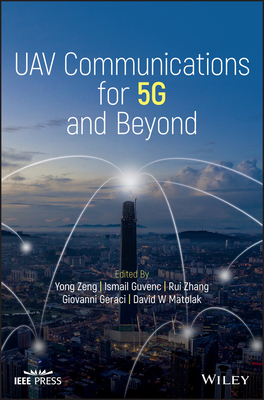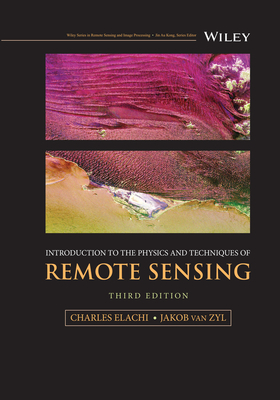Wireless AI: Wireless Sensing, Positioning, Iot, and Communications (Hardcover)
暫譯: 無線AI:無線感測、定位、物聯網與通訊(精裝版)
Liu, K. J. Ray, Wang, Beibei
- 出版商: Cambridge
- 出版日期: 2019-10-03
- 售價: $1,960
- 貴賓價: 9.8 折 $1,921
- 語言: 英文
- 頁數: 622
- 裝訂: Hardcover - also called cloth, retail trade, or trade
- ISBN: 1108497861
- ISBN-13: 9781108497862
-
相關分類:
Machine Learning、Bluetooth、5G
-
相關翻譯:
無線AI應用:無線傳感、定位、物聯網與通訊 (簡中版)
立即出貨 (庫存=1)
買這商品的人也買了...
-
 Practical Radio Frequency Test and Measurement : A Technician's Handbook
Practical Radio Frequency Test and Measurement : A Technician's Handbook$3,120$2,964 -
 Kernel Methods for Remote Sensing Data Analysis (Hardcover)
Kernel Methods for Remote Sensing Data Analysis (Hardcover)$4,980$4,731 -
 Radio Frequency Circuit Design, 2/e (Hardcover)
Radio Frequency Circuit Design, 2/e (Hardcover)$900$882 -
 Software Defined Networking (SDN): Anatomy of OpenFlow Volume I (Paperback)
Software Defined Networking (SDN): Anatomy of OpenFlow Volume I (Paperback)$1,290$1,226 -
 Electromagnetics of Body Area Networks: Antennas, Propagation, and RF Systems
Electromagnetics of Body Area Networks: Antennas, Propagation, and RF Systems$5,790$5,501 -
 Wireless-Powered Communication Networks: Architectures, Protocols, and Applications (Hardcover)
Wireless-Powered Communication Networks: Architectures, Protocols, and Applications (Hardcover)$1,780$1,744 -
 $594深入理解 AutoML 和 AutoDL:構建自動化機器學習與深度學習平臺
$594深入理解 AutoML 和 AutoDL:構建自動化機器學習與深度學習平臺 -
 $352對抗機器學習:機器學習系統中的攻擊和防禦
$352對抗機器學習:機器學習系統中的攻擊和防禦 -
 智能天線:MATLAB 實踐版, 2/e (Smart Antennas with MATLAB, 2/e)
智能天線:MATLAB 實踐版, 2/e (Smart Antennas with MATLAB, 2/e)$534$507 -
 GAN 對抗式生成網路 (GANs in Action: Deep learning with Generative Adversarial Networks)
GAN 對抗式生成網路 (GANs in Action: Deep learning with Generative Adversarial Networks)$750$593 -
 分佈式人工智能:基於 TensorFlow、RTOS 與群體智能體系
分佈式人工智能:基於 TensorFlow、RTOS 與群體智能體系$1,014$963 -
 $1,015基於模型的系統工程有效方法
$1,015基於模型的系統工程有效方法 -
 Uav Communications for 5g and Beyond
Uav Communications for 5g and Beyond$3,680$3,496 -
 Introduction to the Physics and Techniques of Remote Sensing (Hardcover)
Introduction to the Physics and Techniques of Remote Sensing (Hardcover)$1,860$1,823 -
 $454AIoT 系統開發:基於機器學習和 Python 深度學習
$454AIoT 系統開發:基於機器學習和 Python 深度學習 -
 $534結構化壓縮感知理論及應用
$534結構化壓縮感知理論及應用 -
 二次雷達原理與設計
二次雷達原理與設計$1,008$958 -
 雷達系統分析與設計 (MATLAB版), 3/e
雷達系統分析與設計 (MATLAB版), 3/e$954$906 -
 雷達目標檢測與恆虛警處理, 3/e
雷達目標檢測與恆虛警處理, 3/e$768$730 -
 雷達輻射式模擬信號分析與處理
雷達輻射式模擬信號分析與處理$588$559 -
 雷達電子戰系統模擬與評估
雷達電子戰系統模擬與評估$594$564 -
 相控陣雷達技術
相控陣雷達技術$1,320$1,254 -
 Arduino 小型化與 TinyML 應用從入門到精通
Arduino 小型化與 TinyML 應用從入門到精通$539$512 -
 雷達通信的頻譜共享及一體化 關鍵技術與應用
雷達通信的頻譜共享及一體化 關鍵技術與應用$894$849 -
 外輻射源雷達目標探測工程及應用
外輻射源雷達目標探測工程及應用$834$792
相關主題
商品描述
With this groundbreaking text, discover how wireless artificial intelligence (AI) can be used to determine position at centimeter level, sense motion and vital signs, and identify events and people. Using a highly innovative approach that employs existing wireless equipment and signal processing techniques to turn multipaths into virtual antennas, combined with the physical principle of time reversal and machine learning, it covers fundamental theory, extensive experimental results, and real practical use cases developed for products and applications. Topics explored include indoor positioning and tracking, wireless sensing and analytics, wireless power transfer and energy efficiency, 5G and next-generation communications, and the connection of large numbers of heterogeneous IoT devices of various bandwidths and capabilities. Demo videos accompanying the book online enhance understanding of these topics. Providing a unified framework for wireless AI, this is an excellent text for graduate students, researchers, and professionals working in wireless sensing, positioning, IoT, machine learning, signal processing and wireless communications.
商品描述(中文翻譯)
這本開創性的著作探討了無線人工智慧(AI)如何用於以公分級別確定位置、感知運動和生命體徵,以及識別事件和人員。它採用一種高度創新的方法,利用現有的無線設備和信號處理技術,將多徑效應轉化為虛擬天線,結合時間反轉的物理原理和機器學習,涵蓋了基本理論、廣泛的實驗結果以及為產品和應用開發的實際案例。探討的主題包括室內定位和追蹤、無線感測和分析、無線電力傳輸和能源效率、5G及下一代通訊,以及連接大量異質物聯網(IoT)設備的各種頻寬和能力。隨書附上的示範影片增強了對這些主題的理解。這本書為無線AI提供了一個統一的框架,是研究生、研究人員以及從事無線感測、定位、物聯網、機器學習、信號處理和無線通訊的專業人士的優秀參考書。
作者簡介
K. J. Ray Liu, University of Maryland, College Park
K. J. Ray Liu is Christine Kim Eminent Professor of Information Technology in the Department of Electrical and Computer Engineering at the University of Maryland, College Park. A Highly Cited Researcher, he is a Fellow of the Institute of Electrical and Electronics Engineers (IEEE) and the American Association for the Advancement of Science (AAAS), IEEE Vice President, Technical Activities, and a former President of the IEEE Signal Processing Society. He is a recipient of the 2016 IEEE Leon K. Kirchmayer Award, the IEEE Signal Processing Society 2014 Society Award, and the IEEE Signal Processing Society 2009 Technical Achievement Award. He has also co-authored several books, including Cooperative Communications and Networking (Cambridge, 2008).
Beibei Wang, Origin Wireless, Inc., Maryland
Beibei Wang is Chief Scientist in Wireless at Origin Wireless, Inc., and is also affiliated with the University of Maryland. She has been a recipient of the Outstanding Graduate School Fellowship, the Future Faculty Fellowship, the Dean's Doctoral Research Award from the University of Maryland, and the Overview Paper Award from the IEEE Signal Processing Society in 2015. She has co-authored Cognitive Radio Networking and Security: A Game-Theoretic View with K. J. Ray Liu (Cambridge, 2010)
作者簡介(中文翻譯)
K. J. Ray Liu,馬里蘭大學,公園校區
K. J. Ray Liu 是馬里蘭大學電機與計算機工程系的Christine Kim傑出資訊科技教授。他是一位高被引研究者,並且是電氣和電子工程師學會(IEEE)及美國科學促進會(AAAS)的會士,曾擔任IEEE技術活動副總裁及IEEE信號處理學會的前會長。他是2016年IEEE Leon K. Kirchmayer獎、2014年IEEE信號處理學會學會獎及2009年IEEE信號處理學會技術成就獎的獲得者。他還共同撰寫了幾本書籍,包括《合作通信與網絡》(Cambridge, 2008)。
Beibei Wang,Origin Wireless, Inc.,馬里蘭
Beibei Wang 是Origin Wireless, Inc.的無線首席科學家,並且與馬里蘭大學有關聯。她曾獲得馬里蘭大學的傑出研究生獎學金、未來教職獎學金、院長博士研究獎及2015年IEEE信號處理學會的概述論文獎。她與K. J. Ray Liu共同撰寫了《認知無線網絡與安全:博弈論視角》(Cambridge, 2010)。
目錄大綱
. Principles of time reversal and effective bandwidth
Part I. Indoor Locationing and Tracking:
2. Centimeter-accuracy indoor positioning
3. Multi-antenna approach
4. Frequency hopping approach
5. Decimeter-accuracy indoor tracking
Part II. Wireless Sensing and Analytics:
6. Wireless events detection
7. Statistical learning for indoor monitoring
8. Radio biometrics for human recognition
9. Vital signs estimation and detection
10. Wireless motion detection
11. Device-free Speed estimation
Part III. Wireless Power Transfer and Energy Efficiency:
12. Time-reversal for energy efficiency
13. Power waveforming
14. Joint power waveforming and beamforming
Part IV. 5G Communications and Beyond:
15. Time-reversal division multiple access
16. Combating strong-weak resonances in TRDMA
17. Time-reversal massive multipath effect
18. Waveforming
19. Spatial focusing effect for networking
20. Tunnelling effect for cloud radio access network
Part V. IoT Connections:
21. Time-reversal for IoT
22. Heterogeneous connections for IoT
目錄大綱(中文翻譯)
. Principles of time reversal and effective bandwidth
Part I. Indoor Locationing and Tracking:
2. Centimeter-accuracy indoor positioning
3. Multi-antenna approach
4. Frequency hopping approach
5. Decimeter-accuracy indoor tracking
Part II. Wireless Sensing and Analytics:
6. Wireless events detection
7. Statistical learning for indoor monitoring
8. Radio biometrics for human recognition
9. Vital signs estimation and detection
10. Wireless motion detection
11. Device-free Speed estimation
Part III. Wireless Power Transfer and Energy Efficiency:
12. Time-reversal for energy efficiency
13. Power waveforming
14. Joint power waveforming and beamforming
Part IV. 5G Communications and Beyond:
15. Time-reversal division multiple access
16. Combating strong-weak resonances in TRDMA
17. Time-reversal massive multipath effect
18. Waveforming
19. Spatial focusing effect for networking
20. Tunnelling effect for cloud radio access network
Part V. IoT Connections:
21. Time-reversal for IoT
22. Heterogeneous connections for IoT












